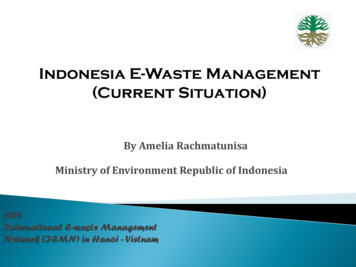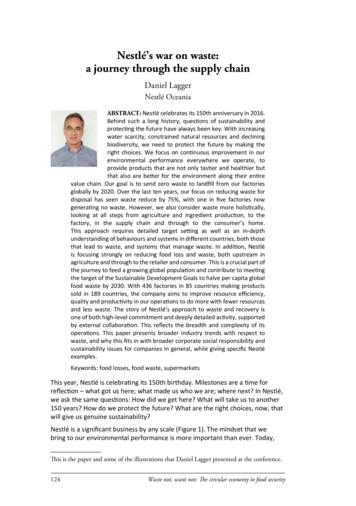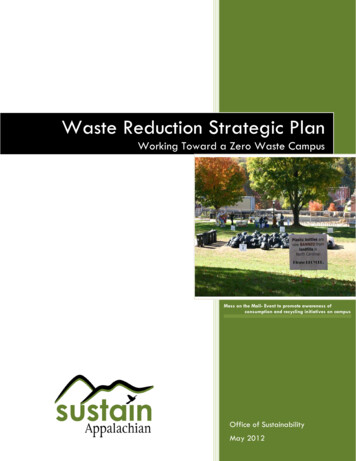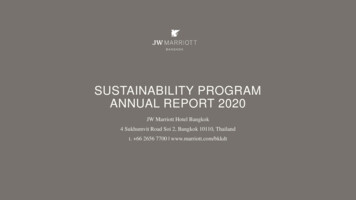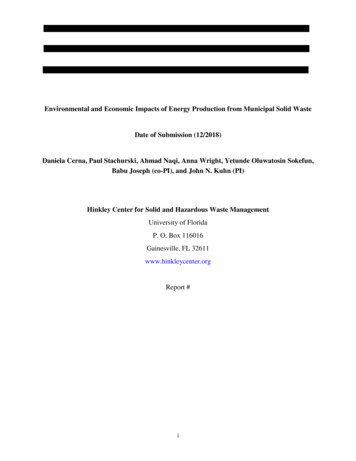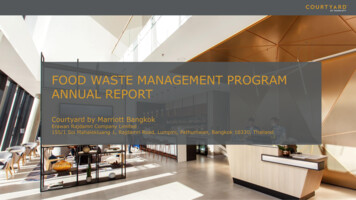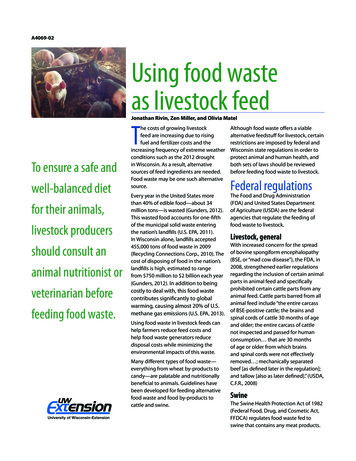
Transcription
A4069-02Using food wasteas livestock feedTJonathan Rivin, Zen Miller, and Olivia MatelTo ensure a safe andwell-balanced dietfor their animals,livestock producersshould consult ananimal nutritionist orveterinarian beforefeeding food waste.he costs of growing livestockfeed are increasing due to risingfuel and fertilizer costs and theincreasing frequency of extreme weatherconditions such as the 2012 droughtin Wisconsin. As a result, alternativesources of feed ingredients are needed.Food waste may be one such alternativesource.Every year in the United States morethan 40% of edible food—about 34million tons—is wasted (Gunders, 2012).This wasted food accounts for one-fifthof the municipal solid waste enteringthe nation’s landfills (U.S. EPA, 2011).In Wisconsin alone, landfills accepted455,000 tons of food waste in 2009(Recycling Connections Corp., 2010). Thecost of disposing of food in the nation’slandfills is high, estimated to rangefrom 750 million to 2 billion each year(Gunders, 2012). In addition to beingcostly to deal with, this food wastecontributes significantly to globalwarming, causing almost 20% of U.S.methane gas emissions (U.S. EPA, 2013).Using food waste in livestock feeds canhelp farmers reduce feed costs andhelp food waste generators reducedisposal costs while minimizing theenvironmental impacts of this waste.Many different types of food waste—everything from wheat by-products tocandy—are palatable and nutritionallybeneficial to animals. Guidelines havebeen developed for feeding alternativefood waste and food by-products tocattle and swine.Although food waste offers a viablealternative feedstuff for livestock, certainrestrictions are imposed by federal andWisconsin state regulations in order toprotect animal and human health, andboth sets of laws should be reviewedbefore feeding food waste to livestock.Federal regulationsThe Food and Drug Administration(FDA) and United States Departmentof Agriculture (USDA) are the federalagencies that regulate the feeding offood waste to livestock.Livestock, generalWith increased concern for the spreadof bovine spongiform encephalopathy(BSE, or “mad cow disease”), the FDA, in2008, strengthened earlier regulationsregarding the inclusion of certain animalparts in animal feed and specificallyprohibited certain cattle parts from anyanimal feed. Cattle parts barred from allanimal feed include “the entire carcassof BSE-positive cattle; the brains andspinal cords of cattle 30 months of ageand older; the entire carcass of cattlenot inspected and passed for humanconsumption that are 30 monthsof age or older from which brainsand spinal cords were not effectivelyremoved ; mechanically separatedbeef [as defined later in the regulation];and tallow [also as later defined].” (USDA,C.F.R., 2008)SwineThe Swine Health Protection Act of 1982(Federal Food, Drug, and Cosmetic Act,FFDCA) regulates food waste fed toswine that contains any meat products.
U S I N GF O O D WA S T EA SL I V E S TO C KCompliance with this Act ensures thatall food waste fed to swine is properlytreated to kill disease organisms. Thislaw mandates that all food waste mustbe boiled for 30 minutes by a licensedtreatment facility prior to arrival at a sitewhere swine are kept, in order to preventdisease transmission. This requirementdoes not include the following items:“Processed products; rendered products;bakery waste; candy waste; eggs;domestic dairy products (includingmilk); fish from the Atlantic Oceanwithin 200 miles of the continentalUnited States or Canada; or fish frominland waters of the United States orCanada which do not flow into thePacific Ocean.” A 2009 amendment alsoexcludes from the boiling requirement“processed products,” or those which aredeemed by the Animal and Plant HealthInspection Service (APHIS; USDA) to haveundergone satisfactory levels of diseaseorganism inactivation.RuminantsAnimal proteins, defined as follows bythe FDA, are prohibited from ruminantfeed: “ any protein-containing portionof mammalian animals, excluding bloodand blood products; gelatin; tallowcontaining no more than 0.15 percentinsoluble impurities inspected meatproducts which have been cooked andoffered for human food and further heatprocessed for feed milk products and any product whose only mammalianprotein consists entirely of porcine orequine protein.” (USDA, C.F.R., 2008)Wisconsin stateregulationsSwineThough it is federally legal to feed toswine food waste containing animalparts that meet the requirements ofthe Swine Health Protection Act, it isunlawful (with certain exemptions)under Wisconsin State Statute 95.10(Feeding of Garbage to Swine) to doso, and Wisconsin state statutesF E E Dsupersede federal law. Accordingto the Wisconsin regulation, “it isunlawful for any person to feed publicor commercial garbage to swine, or todeposit or receive such garbage on anypremises where swine are kept, and noswine having fed on such garbage maybe sold or removed from the premises.”Garbage is defined as “putrescibleanimal or vegetable waste containinganimal parts (includes dairy-basedproducts), resulting from the handling,preparation, processing, cooking orconsumption of food and which iscollected from any source, and includesdead animals [but] does not apply toprivate household waste not removedfrom the premises where produced.”(see Appendix 7, Wisconsin Statute 95:Animal Health 95.10: Feeding of Garbageto Swine, last page)Other LivestockNo state laws govern the feeding of foodwaste to other livestock.Other considerationsUnited States Environmental ProtectionAgency. Food Recovery Challenge,2011 data. www.epa.gov/smm/foodrecovery/.U.S. Environmental Protection Agency.Reducing Food Waste for endix 1By-Product Feedstuffs in Dairy CattleDiets in the Upper Midwest, RandyShaver Professor and Extension DairyNutritionist, Department of DairyScience, College of Agricultural andLife Sciences, University of Wisconsin–Madison, University of WisconsinExtension, 18 pages.Appendix 2Feeding Cull Potatoes to Dairy and BeefCattle, Ken Schroeder, UW-ExtensionAgriculture Agent, Portage County,UW‑Extension, October 2012, 4 pages.Appendix 3Feeding Cabbage Waste, Liz Binversie,UW‑Extension Dairy and LivestockEducator, Outagamie County; ZenMiller, UW-Extension Dairy andLivestock Agent, Outagamie County;UW‑Extension, May 2013, 2 pages.The regulations cited above only definethe legal requirements for feeding foodwaste to livestock. They do not addressthe nutritional needs of livestock animalsor the nutritional quality of the variousAppendix 4kinds of food waste. To ensure a safeBy-Product Feed Ingredients for Use in Swineand well-balanced diet for their animals,Diets, Nutrition Guide, Bob Thaler, Southlivestock producers should consult anDakota State University; Palmer Holden,animal nutritionist or veterinarian beforeIowa State University, National Swine,feeding food waste.12 pages.References2009 Wisconsin Statewide WasteCharacterization Study. Final Report.2010. Recycling ConnectionsCorporation. Stevens Point, WI.Gunders, Dana. Natural Resources DefenseCouncil Issue Paper, 2012. “Wasted: HowAmerica is losing up to 40 percent of itsfood from farm to fork to landfill”(IP:12-06-B). www.nrdc.org/food/files/wasted-food-IP.pdf.U.S. Department of Agriculture. Code ofFederal Regulations Title 21. 2008. pt.589.2000, 2001.2Appendix 5Alternative Feed Ingredients in Swine DietsII: Use, Advantages and Disadvantagesof Common Alternative Feedstuffs, PorkCheckoff, National Pork Board, 25 pages.Appendix 6Animal Proteins Prohibited in Ruminant Feed& Cattle Materials Prohibited in All AnimalFeed, Washington State Department ofAgriculture, Agr Pub 631-282 (N/10/09),8 pages.wAppendix 7Wisconsin Statute 95: Animal Health 95.10:Feeding of Garbage to Swine
Appendix 1By-Product Feedstuffs in Dairy Cattle Diets in the Upper MidwestRandy ShaverProfessor and Extension Dairy NutritionistDepartment of Dairy ScienceCollege of Agricultural and Life SciencesUniversity of Wisconsin –MadisonUniversity of Wisconsin ExtensionIntroductionThe purpose of this paper is to review by-product feedstuffs commonly used indairy cattle diets in the Upper Midwest. Typical nutrient analyses of most of thesefeedstuffs are provided in Table 1. Otherwise nutrient composition is listed in the text.Tabular listings of nutrient analyses are average values, and the variation in nutrientcontent of by-product feedstuffs can be large (Dairy NRC, 2001). Laboratory testing ofby-product feedstuffs for actual nutrient content is recommended.Break-even costs can be calculated using FEEDVAL4 (Howard and Shaver,1993; s.cfm) where blood meal(rumen undegraded protein; RUP), urea (rumen degraded protein; RDP), shelled corn(energy), tallow (fat), dicalcium phosphate (phosphorus) and calcium carbonate(calcium) serve as referee feedstuffs. Break-even costs are not provided herein,because they vary as prices of the referee feedstuffs change from month to month, yearto year, supplier to supplier, and location to location. Calculation of relevant breakevenprices is recommended.Some general guidelines on upper feeding limits for by-product feedstuffs(Howard, 1988) are provided herein, however, actual feeding rates should bedetermined through formulation of diets to meet specifications for neutral detergent fiber(NDF), nonfiber carbohydrate (NFC), fat and protein fractions (crude protein; CP, RDP,and RUP). Fiber effectiveness factors and feedstuff definitions provided herein wereobtained from Armentano and Clark (1992) and The Feed Industry Red Book (1994),respectively.High-Fiber ByproductsBeet Pulp is the dried residue from sugar beets which has been cleaned andfreed from crowns, leaves and sand, and which has been extracted in the process ofmanufacturing sugar. Beet pulp with molasses includes the beet molasses obtained inthe manufacture of sugar. Beet pulp is bulky and highly palatable. It may be fed dry orwet. It may be sold in either pelleted or meal form. Upper feeding limits on beet pulp areabout half of the grain concentrate or 8 to 15 lb of dry matter (DM) per cow per day.Beet pulp is often used to reduce the content of NFC in dairy cattle diets. Much of theNFC in beet pulp is pectin which has a propensity for acetate versus propionate
production in the rumen. The NDF in beet pulp is highly fermentable in the rumen, and itcan be used to supply fermentable fiber in the diet. Inclusion of beet pulp in earlylactation diets allows the formulation of high NDF, moderate NFC diets of high energydensity. Beet pulp is also used as a forage replacer, however, it has limited foragereplacement value; effectiveness factor of 0.43 (fraction of NDF) versus 1.0 for forages.The upper limit on forage replacement is 15 to 25% of the forage DM in the diet.Brewers Dried Grains (BDG) is the dried extracted residue of barley malt alone or inmixture with other cereal grain or grain products resulting from the manufacture of wortor beer and may contain pulverized dried spent hops in an amount not to exceed 3%,evenly distributed. The higher fraction of RUP relative to soybean meal (SBM) makesBDG attractive in diets for lactating dairy cows. BDG are commonly used by the feedindustry as a component of protein supplements for dairy cattle. The formula feedindustry generally limits BDG to less than 50% of protein supplements and 25% ofcomplete feeds for dairy cattle. BDG are highly palatable. Upper feeding limits on BDGare 5 to 10 lb. of DM per cow per day. BDG have limited value as a source of RUP inhigh corn silage diets because of their low lysine content. BDG are often used to reducethe content of NFC in dairy cattle diets. BDG are also used as a forage replacer,however, they have limited forage replacement value; effectiveness factor of 0.33(fraction of NDF) versus 1.0 for forages. The upper limit on forage replacement is 10 to15% of the forage DM in the diet.Brewers Wet Grains (BWG) is the extracted residue from the manufacture of wort frombarley malt alone or in mixture with other cereal grains or grain products. Theguaranteed analysis shall include the maximum moisture. Typical nutrient analyses aresimilar to BDG, except for moisture content which may range from 70 to 80%. Theprimary market for BWG is dairy farms and beef cattle feedlots in relatively closeproximity to the brewery. The high moisture content of BWG limits its use to livestockoperations near the point of production or within a few hundred miles of majorbreweries. BWG are incorporated directly into rations at the farm. Feeding levels aregenerally in the range of 20 to 40 lb/cow/day (as fed basis) for dairy cattle. Precautionsare generally taken to not increase dietary moisture content above 55%. Adding BWGto diets containing low-moisture hay-crop silages (less than 50% moisture) mayincrease consumption of a total mixed ration (TMR). The supply should be turned every7 to 10 days to keep BWG fresh and acceptable to livestock. This limits their use insmall herds, but some suppliers avoid this problem by delivering BWG in silage bagswhich allows on-farm storage for a month or more without spoilage. Comments made inthe section on BDG apply here as well.Corn gluten feed (CGF) is that part of commercial shelled corn that remains after theextraction of the larger portion of the starch, gluten and germ by the processesemployed in the wet milling manufacture of corn starch or syrup. It may or may notcontain fermented corn extractives and (or) corn germ meal. It may be fed dry or wet. Itmay be sold in either pelleted or meal form. Wet CGF contains about 45 percent DM.Upper feeding limits on CGF are 12 to 15 lb. and 8 to 12 lb. of DM per cow per day fordry and wet CGF, respectively. For wet CGF, feeding levels are generally in the range
of 15 to 25 lb/cow/day (as fed basis). The supply should be turned every 7 to 10 days tokeep wet CGF fresh and acceptable to livestock. This limits its use in small herds. Sulfurconcentrations of 0.70% (DM basis) in CGF samples have been reported which maycreate thiamin-related problems at high inclusion rates; therefore, obtaining an analysisfor S on CGF sources so that diets can be adjusted accordingly is recommended. Theinclusion rate of CGF is often restricted because of its high content of soluble proteinand RDP. Relative to dry CGF, the wet product has a higher content of soluble proteinand RDP. The RUP in CGF has limited value because of its low lysine content,particularly in high corn silage diets. CGF is generally used as a grain replacer. Used inthis manner it lowers the content of NFC in dairy cattle diets. CGF is also used as aforage replacer; effectiveness factor of 0.56 (fraction of NDF) versus 1.0 for forages.The upper limit on forage replacement is 20 to 25% of the forage DM in the diet.Cottonseeds. Whole cottonseed is the unprocessed and unadulterated oilseed whichhas been separated from the cotton fiber. Delinted cottonseed is the unprocessed andunadulterated oilseed which has been separated from the cotton fiber with less than 5%retained lint. Cottonseeds are fed to high producing dairy cows for a source of fat andfiber. They are often used as a forage replacer. Delinted cottonseed contains slightlymore protein, fat and energy, but less fiber, than whole cottonseed. There are bothmechanically and acid delinted cottonseed products. The mechanically delintedcottonseed is more palatable than acid delinted cottonseed, and is the preferreddelinted product for dairy cows. Little difference in animal performance between wholecottonseed and mechanically delinted cottonseed has been reported (Coppock andWilks, 1991). Upper feeding limits on cottonseeds are 6 to 7 lb. of DM per cow per day.The inclusion rate of cottonseeds is often restricted because of their high fat contentand the use of other high-fat ingredients in the diet. Precautions are generally taken tonot supplement dietary fat from high-fat plant sources above 1.5 lb. per cow per day.Cottonseeds are often used as a grain replacer. Used in this manner they lower thecontent of NFC in dairy cattle diets. Cottonseeds are an excellent forage replacer;effectiveness factor similar to chopped silages. The upper limit on forage replacement is25 to 35% of the forage DM in the diet. Relative to mechanically delinted cottonseed,whole cottonseed is on the high end of this range for replacement of dietary forage.Gossypol toxicity or adverse subclinical effects of gossypol on reproduction should notbe a concern when no more than 15% cottonseed products (cottonseeds andcottonseed meal) are included in the total diet DM. Cottonseeds should be monitored foraflatoxin contamination. This is especially true for gin-run cottonseed that may be highin moisture content causing mold problems in storage. This cottonseed may be offeredat a lower price, but may not be a good buy when potential storage problems and thehigher moisture content are considered.Distillers Dried Grains (DDG) is obtained after the removal of ethyl alcohol bydistillation from the yeast fermentation of a grain or grain mixture by separating theresultant coarse grain fraction of the whole stillage and drying by methods employed inthe grain distilling industry. The predominant grain shall be declared as the first word inthe name; barley, cereals, corn, rye, sorghum, and wheat. The higher fraction of RUPrelative to SBM makes DDG attractive in diets for lactating dairy cows. DDG are
commonly used by the feed industry as a component of protein supplements for dairycattle. The formula feed industry generally limits DDG to less than 50% of proteinsupplements and 25% of complete feeds for dairy cattle. DDG are highly palatable.Upper feeding limits on DDG are listed at 10 to 15 lb. of DM per cow per day, but limitson daily intakes of 5 to 10 lb. of DM per cow are more common. The inclusion rate ofDDG is often restricted because of its high fat content and the use of other high-fatingredients in the diet. Precautions are generally taken to not supplement dietary fatfrom high-fat plant sources above 1.5 lb. per cow per day. DDG have limited value as asource of RUP in high corn silage diets because of their low lysine content. One qualityconcern with DDG is heat-damaged protein. Acid detergent insoluble nitrogen (ADIN) isthe method typically used by forage testing laboratories to estimate heat damagedprotein. DDG can be high in ADIN; ranging from 10 to 40% of CP (Chase. 199 1). Poorperformance by lactating dairy cows has been observed when feeding DDG containing25% to 35% of the CP in the ADIN fraction. Finding some protein in the ADIN fraction isa normal occurrence in protein supplements that undergo heating during processing,and lower concentrations probably do not limit animal performance because a portion ofthe ADIN is digestible. DDG are often used to reduce the NFC content of dairy cattlediets. DDG are also used as a forage replacer; effectiveness factor is 0.76 versus 1.0for forages. The upper limit on forage replacement is 20 to 30% of the forage DM in thediet.Distillers Dried Grains With Solubles (DDGS) is the product obtained after theremoval of ethyl alcohol by distillation from the yeast fermentation of a grain or grainmixture by condensing and drying at least three-fourths of the solids of the wholestillage by methods employed in the grain distilling industry. The predominant grain shallbe declared as the first word in the name; barley, cereals, corn, rye, sorghum, andwheat. Comments made in the section on DDG apply here as well.Distillers Solubles is obtained after the removal of ethyl alcohol by distillation from theyeast fermentation of a grain or grain mixture by condensing the thinstillage fraction and drying it by methods employed in the grain distilling industry. Thepredominant grain shall be declared as the first word in the name; barley, cereals, corn,rye, sorghum, and wheat. Most distilleries add the liquid solubles to the grains and donot produce dried solubles. Condensed distillers solubles is obtained after the removalof ethyl alcohol by distillation from the yeast fermentation of a grain or grain mixture bycondensing the thin stillage fraction to a semisolid. The predominant grain shall bedeclared as the first word in the name. Condensed distillers solubles can be marketedas a liquid feed ingredient. Contents of DM from 8 to 26% and CP from 30 to 35% (DMbasis) for condensed distillers solubles have been reported in research trials (Chase,1991). Cornell workers added condensed distillers solubles (26% DM) to rations forearly lactation dairy cows at 0, 8, and 16% of total ration DM (Chase, 1991). Feedintake, milk production, and milk composition were similar for the three rations.Maximum daily intake of condensed distillers solubles was about 30 lb per cow (8 lb percow of DM).
Distillers Wet Grains (DWG) is the product obtained after the removal of ethyl alcoholby distillation from the yeast fermentation of a grain or grain mixture. The guaranteedanalysis shall include the maximum moisture. Typical nutrient analyses are similar todistillers dried grains, except for moisture. DWG is usually about 35% DM. A partiallydried DWG marketed as “modified” DWG is usually about 48% DM. Feeding limits aresimilar to those provided for DDG on DM basis. Comments made in the section onBWG regarding storage and handling apply here as well.Hominy feed is a mixture of corn bran, corn germ and part of the starchy portion ofeither white or yellow corn kernels or mixture thereof, as produced in the manufacture ofpearl hominy, hominy grits, or table meal, and must contain not less than 4 percent fat.The fiber, starch and fat content of hominy feed can vary; laboratory analysis isrecommended. Hominy feed is generally used as a grain replacer. It is similar to earcorn in content of fiber and non-fiber carbohydrates and energy. The physical form ofhominy feed is fine relative to dry corn that is typically processed on-farm, whichenhances its energy value and content of ruminally-fermentable carbohydrate. Upperfeeding limits on hominy feed are 10 to 15 lb. of DM per cow per day. The inclusion ratefor hominy feed may need to be restricted if it tests high in fat content and other high-fatingredients are being used in the diet. Precautions are generally taken to notsupplement dietary fat from high-fat plant sources above 1.5 lb. per cow per day.Malt Sprouts are obtained from malted barley by the removal of the rootlets andsprouts, which may include some of the malt hulls, other parts of malt, and foreignmaterial unavoidably present. It must contain not less than 24% CP. The term "maltsprouts" when applied to the corresponding portion of other malted cereals must beused in qualified form, as, for example: "rye malt sprouts" and "wheat malt sprouts".Malt sprouts are commonly used by the feed industry as a component of proteinsupplements for dairy cattle. Upper feeding limits on malts sprouts are the same as forBDG. Malt sprouts are often used to reduce the NFC content of dairy cattle diets and asa forage replacer. However, they have limited forage replacement value; effectivenessfactor of 0.48 versus 1.0 for forages. The upper limit on forage replacement is 15 to25% of the forage DM in the diet.Soy Hulls consist primarily of the outer covering of the soybean. Upper feeding limitson soy hulls are 8 to 12 lb. of DM per cow per day. Soy hulls are often used to reducethe content of NFC in dairy cattle diets. The NDF in soy hulls is highly fermentable in therumen, and it can be used to supply fermentable fiber in the diet. Inclusion of soy hullsin early lactation diets allows the formulation of high NDF, moderate NFC diets of highenergy density. Soy hulls have limited value as a forage replacer; effectiveness factor at0.25 (fraction of NDF) and the upper limit on forage replacement at 10% of the forageDM in the diet. Soybean mill feed is composed of soybean hulls and the offal from thetail of the mill which results from the manufacture of soy grits or flour. It must contain notless than 13.0% CP and not more than 32.0% crude fiber. The protein, fiber and fatcontent of soybean mill feed can vary; laboratory analysis is recommended. Oneproduct, soybean screenings, has a typical nutrient analysis (DM basis) of 30% CP,20% ADF, 30% NDF and 12% EE. This product can have a high percentage of weed
seeds. Its inclusion rate is restricted to 5 to 10 lb. per cow per day because of its highfat content and the use of other high-fat ingredients in the diet. Precautions aregenerally taken to not supplement dietary fat from high-fat plant sources above 1.5 lb.per cow per day.Wheat By-Products. Wheat bran is the coarse outer covering of the wheat kernel asseparated from cleaned and scoured wheat in the usual process of commercial milling.Wheat middlings consist of fine particles of wheat bran, wheat shorts, wheat germ,wheat flour, and some of the offal from the tail of the mill. This product must be obtainedin the usual process of commercial milling and must contain not more than 9.5% crudefiber. It may be sold in either pelleted or meal form. Upper feeding limits on wheat branand wheat middlings are 5 to 10 lb. and 10 to 15 lb. of DM per cow per day,respectively. Wheat bran is palatable, mildly laxative and highly bulky making it fairlypopular in concentrates for dry cows. The inclusion rate of wheat midds in milking cowdiets are often restricted because of their high content of RDP. Wheat midds aregenerally used as a grain replacer. Used in this manner they lower the content of NFCin dairy cattle diets. Wheat midds are also used as a forage replacer; effectivenessfactor of 0.57 (fraction of NDF) versus 1.0 for forages. The upper limit on foragereplacement is 20 to 25 percent of the forage DM in the diet.High-Protein ByproductsPlant SourcesCanola Meal consists of the meal obtained after the removal of most of the oil, either bydirect or prepress solvent extraction processes, from rapeseed (Brassica spp.), the oilcomponent of which contains less than 2% erucic acid and the solid component ofwhich contains less than 30 micromoles of glucosinolates per gram of air-dry, oil-freesolid. It must contain a minimum of 35% protein, a maximum of 12% crude fiber, and amaximum of 30 micromoles of glucosinolates per gram. Upper feeding limits for canolameal are 5 to 8 lb. of DM per cow per day. The inclusion rate of canola meal in milkingcow diets is often restricted because of its high content of RDP.Corn Gluten Meal (CGM) is the dried residue from corn after the removal of the largerpart of the starch and germ, and the separation of the bran by the process employed inthe wet milling manufacture of corn starch or syrup, or by enzymatic treatment of theendosperm. It may or may not contain fermented corn extractives and (or) corn germmeal. Upper feeding limits on CGM are 2 to 3 lb. of DM per cow per day. Palatabilitymay be a problem when fed in a protein top-dress. The higher fraction of RUP relativeto SBM makes CGM attractive in diets for lactating dairy cows. CGM is commonly usedby the feed industry as a component of protein supplements for dairy cattle. The RUP inCGM has limited value because of its low lysine content, particularly in high corn silagediets. However, CGM is high in methionine and is often combined with high lysinebypass protein supplements like animal-marine protein by-products and heat-treatedsoybean products in protein blends. As with DDG, high ADIN may also be a concern forcorn gluten meal.
Cottonseed Meal (CSM) is the product obtained by finely grinding the flakes whichremain after removal of most of the oil from cottonseed by a solvent extraction process(solvent-extracted meal) or by finely grinding the cake which remains after removal ofmost of the oil from cottonseed by a mechanical extraction process (mechanicallyextracted meal). It must contain not less than 36% CP. Its fiber content is higher andenergy content lower than SBM. There are no feeding limits for CSM, but restrictionsare generally imposed through formulation of diets to meet specifications for CP, RUPand RDP. Protein degradability is fairly high and similar to SBM. Gossypol toxicity oradverse subclinical effects of gossypol on reproduction should not be a concern whenno more than 15% cottonseed products (cottonseeds and cottonseed meal) areincluded in the total diet DM. This upper feeding limit should be monitored when bothwhole cottonseeds and cottonseed meal are fed.Linseed Meal is the product obtained by grinding the flakes which remain after theremoval of most of the oil from flaxseed by a solvent extraction process (solventextracted meal) or by grinding the cake or chips which remain after removal of most ofthe oil from flaxseed by a mechanical extraction process (mechanically-extracted meal).There are no feeding limits for linseed meal, but restrictions are generally imposedthrough formulation of diets to meet specifications for CP, RUP and RDP. Proteindegradability is high and similar to SBM. Linseed meal is palatable and mildly laxative.Its fiber content is higher and energy content lower than SBM.Soybean Meal (SBM) is the product obtained by grinding the flakes which remain afterremoval of most of the oil from either whole or dehulled soybeans by a solventextraction process (solvent extracted meals). The product resulting from wholesoybeans must contain not more than 7.0% crude fiber and not more than 12.0%moisture. The product resulting from dehulled soybeans must contain not more than3.5% crude fiber and not more than 12.0% moisture. Mechanically extracted SBM is theproduct obtained by grinding the cake or chips which remain after removal of most ofthe oil from whole soybeans by a mechanical extraction process. It must contain notmore than 7.0% crude fiber and not more than 12.0% moisture. Meals resulting fromwhole and dehulled soybeans contain 44% and 48%
(Federal Food, Drug, and Cosmetic Act, FFDCA) regulates food waste fed to swine that contains any meat products. Jonathan Rivin, Zen Miller, and Olivia Matel To ensure a safe and well-balanced diet for their animals, livestock producers should consult an animal nutritionist or
